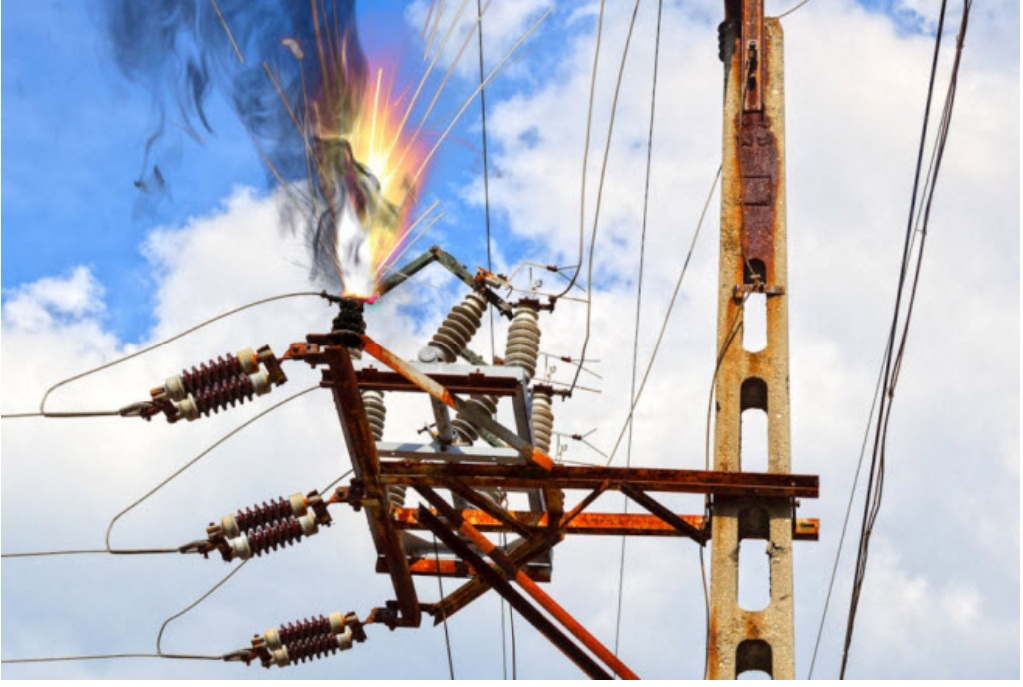Types of overhead line faults,symtrical and unsymetrical types of fault in detail
A fault in an overhead power line refers to an abnormal condition that disrupts the normal flow of electricity through the line. It can occur due to various factors, such as equipment malfunction, environmental conditions, physical damage, or other issues. Faults can lead to unintended electrical connections, interruptions in power supply, and potential hazards to both the power system and people.
 |
Types of overhead line faults:
1. Short circuit fault:
- A short circuit occurs when two conductors of different phases are inadvertently connected or connected between a phase conductor and ground. This creates a low-resistance path for current flow, resulting in current spikes.
- Short circuits are often caused by damaged insulation, equipment failure, or accidental contact with an object such as a tree branch. It can cause overheating, damage to equipment and even fire.
2. Open Circuit fault:
- An open circuit occurs when an open circuit occurs in one or more conductors, interrupting the flow of current. This can be caused by physical damage to the conductors, such as broken or broken wires or poor connections.
- Open circuit faults can cause loss of power and affect normal operation of the electrical system.
3. Earth Fault:
- A ground fault occurs when one or more of the phase conductors make contact with earth or a conductive surface. This can be caused by factors such as poor insulation, damage to equipment, or physical contact with objects.
- Ground faults can cause electrical current to flow to ground, resulting in electric shock, equipment damage, and safety hazards.
4. Corona Discharge
- Corona discharge is a phenomenon where the electric field around a conductor is strong enough to ionize the surrounding air, causing a visible blue or violet glow.
- Due to its erosive action, corona can cause power loss, audible noise, and even damage to conductor insulation.
5. Dielectric breakdown:
- Dielectric breakdown occurs when the insulation between conductors is destroyed due to overvoltage.
- This can create an electric arc between the conductors or to ground, causing a short circuit and possible damage to the conductors and equipment.
Symmetrical and unsymmetrical types of faults
let's explore symmetrical and unsymmetrical type of faults in more detail:
1. Symmetrical Fault (Balanced Fault):
- A symmetrical fault, also known as a balanced fault, is a fault in which the three-phase voltages or currents remain balanced even during the fault condition. In other words, the fault occurs in a symmetric manner across all three phases.
- Symmetrical faults are typically caused by insulation breakdown, conductor faults, or short circuits that affect all three phases equally.
2.The three-phase line to the ground fault (LLLG):
The three-phase line to ground fault includes all the three-phase of the system. The LLLG fault occurs between the three phases and the ground of the system. The probability of occurrence of such type of fault is nearly 2 to 3 percent.
2. Asymmetrical faults (unbalanced faults)
- An imbalance fault, also called an imbalance fault, is an error condition in which the three phase voltages or currents are not equal or unbalanced. This can happen when a fault affects one or more phases differently than others.
- Unbalanced faults can be caused by a variety of factors, including poor insulation, line-to-line or line-to-line ground contact, and equipment failure.
There are three main types of asymmetric faults
Single Line to ground fault:
- In case one phase is in contact with ground. This results in an unbalanced fault condition where the current in the faulted phase is higher than the current in the other two phases.
- The 70 – 80 percent of the fault in the power system is the single line-to-ground fault.
Double line to Ground Fault:
- Here two phases are in contact with ground. The fault currents of the affected phases are much higher than single-phase ground faults, resulting in significant unbalance.
- The probability of such types of faults is nearly 10 %.
Line-to-line faults (phase-to-phase)
- Like symmetric errors, line-to-line errors can also be asymmetric if the errors affect the phase differently. This can happen if the error occurs at different distances from the source for different phases.
- Asymmetrical faults can lead to uneven loading of electrical equipment, voltage imbalance and current imbalance in power systems. Safety relays and circuit breakers are designed to detect and correct these faults to minimize impact on power system reliability and equipment.
- The percentage of such types of faults is approximately 15 – 20%.
The severity of faults:
- Among the given faults, LLLG or 3 phase faults are the most severe. LG or line to ground fault is least severe.
- The line to line fault is more severe than the line to a ground fault while the double line to ground fault is one level severe than LL.
- The order of frequency of occurrence is given below.
LLLG > LLG > LL > LG
Image contribution:
Electrical faults : https://forschung-stromnetze.info/fileadmin/user_upload/Projekte/2015/ISOSTROSE/Titelbild_ISOSTROSE.jpg



